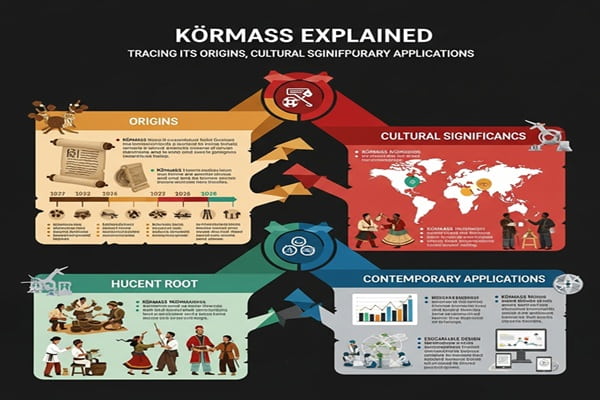
Let’s start by breaking it down in simple terms. Körmass isn’t just a word—it’s an idea, a tradition, and for many, a living symbol of community and continuity. Though it may not have a single definition, Körmass reflects the way people come together—through rituals, shared celebrations, or collective work—to express identity and belonging.
Think of it as a cultural bridge connecting generations. Whether it’s tied to old ceremonies, local gatherings, or even modern reinterpretations, Körmass carries the spirit of togetherness and transformation. It’s the kind of concept that changes shape over time but never loses its heart.
This guide unpacks Körmass from every angle—its history, linguistic roots, cultural meanings, and how it continues to inspire communities worldwide.
1. The Historical Roots of Körmass
The story of Körmass begins in small, tight-knit communities where life revolved around shared responsibility. Historically, it was used to describe communal gatherings—occasions where people came together to exchange goods, celebrate seasonal milestones, or reinforce social bonds.
In agricultural societies, these gatherings marked the rhythm of the year: harvest festivals, planting ceremonies, or end-of-season feasts. Körmass was both practical and symbolic—it ensured cooperation and reinforced a sense of unity in communities that relied on one another for survival.
Over time, Körmass became more than just a local event. It turned into a cultural marker, a way for people to affirm who they were and where they came from. Even as lifestyles changed, the sense of connection embedded in Körmass never disappeared.
2. The Language Behind Körmass
The term Körmass carries linguistic depth that mirrors its cultural significance. Its structure hints at old regional expressions that may have related to measurement, gathering, or sharing—concepts deeply woven into traditional life.
Linguists believe that words like Körmass evolved organically, shaped by dialects and everyday experience. What makes it so fascinating is how it functions on two levels: as a practical term used in everyday life and as a symbolic expression of cultural values.
This dual meaning gave Körmass longevity. It wasn’t just a label—it became part of the language of belonging, a word that carried both meaning and emotion for those who used it.
3. Körmass as a Cultural Experience
If you’ve ever attended a festival where people dance, share food, and celebrate under the same sky, you’ve felt the spirit of Körmass. These gatherings are sensory experiences—filled with color, music, and emotion.
Traditionally, Körmass was associated with:
-
Harvest celebrations – thanking nature for abundance
-
Community festivals – strengthening social ties
-
Religious rituals – honoring shared beliefs
-
Music and dance – expressing joy and togetherness
-
Shared meals – reinforcing unity through food
It’s this mix of ritual and joy that keeps Körmass alive across generations. What began as a necessity for survival has transformed into a cherished symbol of continuity.
4. Körmass as a Social Framework
Beyond the celebrations, Körmass has always played a deeper social role. It acts as a kind of moral compass—a reminder that balance, fairness, and mutual support are vital for community life.
In traditional contexts, Körmass often guided how people worked together, distributed resources, or supported each other through hardship. You could think of it as an early social contract, where cooperation wasn’t optional but essential.
Even today, this concept continues to inspire. Modern thinkers use Körmass as a metaphor for work-life balance, community ethics, and sustainable growth. It’s a timeless reminder that progress without connection loses its meaning.
5. Körmass in the Modern Era
Although it began in rural traditions, Körmass has found new life in urban and digital spaces. Diaspora communities, for instance, celebrate Körmass-like events to preserve heritage and stay connected with their roots.
Meanwhile, cultural organizations and scholars reinterpret Körmass through heritage festivals, academic studies, and even sustainability initiatives.
Here’s a quick look at how Körmass has evolved:
| Context | Traditional Meaning | Modern Adaptation |
|---|---|---|
| Agricultural | Harvest and food sharing | Symbol of eco-conscious living |
| Religious | Community worship | Spiritual mindfulness and balance |
| Social | Strengthening local bonds | Reconnecting global communities |
| Ethical | Duty and fairness | Metaphor for personal and societal harmony |
| Cultural Identity | Heritage preservation | Cultural branding and education |
The beauty of Körmass lies in its adaptability. It proves that tradition doesn’t have to fade—it just needs to evolve.
6. The Global Relevance of Körmass
Though rooted in local cultures, Körmass has a message that resonates far beyond its origins. Across the globe, people are rediscovering the importance of community, sustainability, and shared purpose—the very values Körmass embodies.
From cultural preservation projects to eco-conscious movements, the essence of Körmass shows up everywhere. It reminds us that progress isn’t just about moving forward—it’s about remembering where we came from and nurturing balance along the way.
By emphasizing cooperation over competition, Körmass echoes global conversations around climate resilience, mental health, and social equity.
7. Körmass in Art, Identity, and Media
Artists, musicians, and writers have long drawn inspiration from Körmass. Traditional songs and stories continue to preserve its imagery—fields of gold, shared laughter, and unity under open skies.
In modern times, filmmakers and digital creators reinterpret Körmass as a metaphor for belonging and identity. These artistic efforts keep the term alive for younger generations, even those far removed from its original setting.
For diaspora communities, celebrating Körmass—whether through art, language, or symbolic rituals—serves as a powerful link to ancestry. It’s both a memory and a renewal, helping people stay rooted while embracing new environments.
Also Read : “hcooch ch2 h2o”: An In-Depth Exploration of Reaction Pathways, Properties, and Applications
The Deeper Meaning Behind Körmass
At its core, Körmass represents continuity through change. It’s about holding on to tradition while allowing it to evolve. A cultural scholar once said, “Tradition isn’t the worship of ashes—it’s the preservation of fire.” Körmass captures that spirit perfectly.
Each generation redefines it, ensuring it remains relevant without losing its essence. It’s a reminder that heritage isn’t static—it’s alive, breathing, and adapting just like the people who carry it forward.
Why Körmass Still Matters
Körmass continues to matter because it bridges the past and present. It connects people to their roots while inspiring modern ideas of sustainability, balance, and togetherness.
To study Körmass is to understand how cultures survive and thrive—not by resisting change but by adapting gracefully. Whether experienced as a festival, a philosophy, or a metaphor, Körmass reminds us of something universal: our shared need for connection.
FAQs About Körmass
1. What does Körmass mean?
Körmass represents a traditional concept rooted in communal gatherings, balance, and cultural identity.
2. Is Körmass still practiced today?
Yes. Many communities continue traditional Körmass festivals, while others reinterpret it through cultural and social initiatives.
3. How has Körmass adapted to modern life?
It has evolved into a metaphor for sustainability, community ethics, and personal balance in modern society.
4. Why is Körmass important for cultural identity?
It gives individuals a sense of belonging and continuity, linking them to their heritage even across generations.
5. Can Körmass have global relevance?
Absolutely. Its focus on unity, tradition, and sustainable growth resonates with global movements toward connection and mindfulness.
Final Thought:
Körmass is more than a tradition—it’s a living story of humanity’s ability to stay connected through change. Whether celebrated in a village square or remembered in a city apartment, its essence endures: the power of community, balance, and shared identity.


